禁行区
INFO
阅读本文预计 10 分钟
项目中经常存在一些区域对部分角色开放,对其他角色不开放的情况。可以使用【禁行区】给某一个区域添加进出权限管理能力完成上述使用场景。通过【禁行区】我们可以给角色动态设置通行权限,阻挡玩家角色进入或者限制玩家角色的活动范围。
禁行区对象
【禁行区】是一种功能对象,在项目中用来控制一片区域对其他对象的通行权限。你可以自定义【禁行区】的属性来控制区域的位置,大小和旋转。在检测到对象接近区域边缘后,【禁行区】会检测该对象是否有通过权限并返回对应的碰撞结果。你可以在【本地资源库】中的【游戏功能对象】栏中找到【禁行区】。
| 中文示例 | 英文示例 |
|---|---|
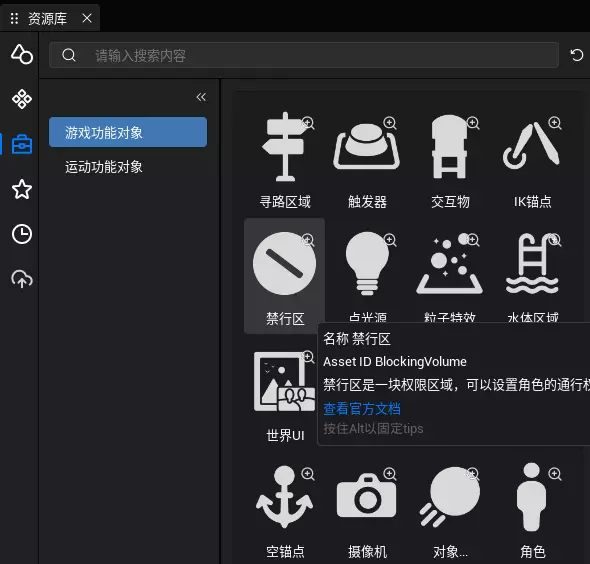 | 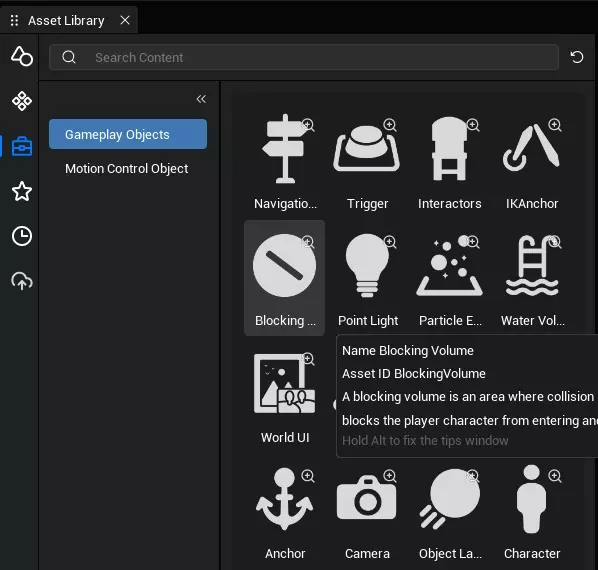 |
创建禁行区
通过放置资源创建:
【禁行区】本身作为一个游戏对象可以放置于游戏场景中。你可以从【本地资源库】中的【游戏功能对象】栏将【禁行区】拖入【场景】或者【对象管理器】来创建对象。
- 在【本地资源库】的【游戏功能对象】栏中找到【禁行区】
| 中文示例 | 英文示例 |
|---|---|
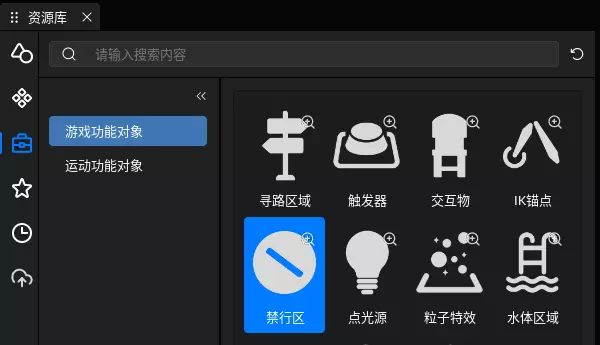 | 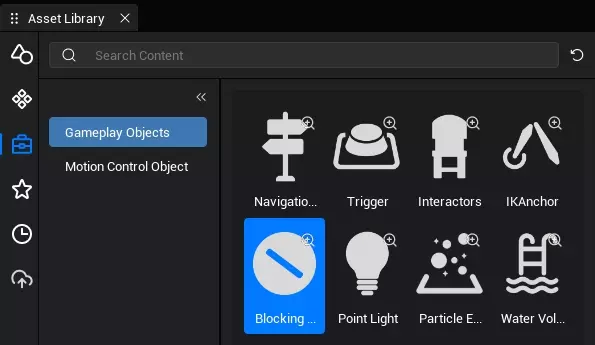 |
- 将对象拖入到场景中或者【对象管理器】
| 中文示例 | 英文示例 |
|---|---|
 | 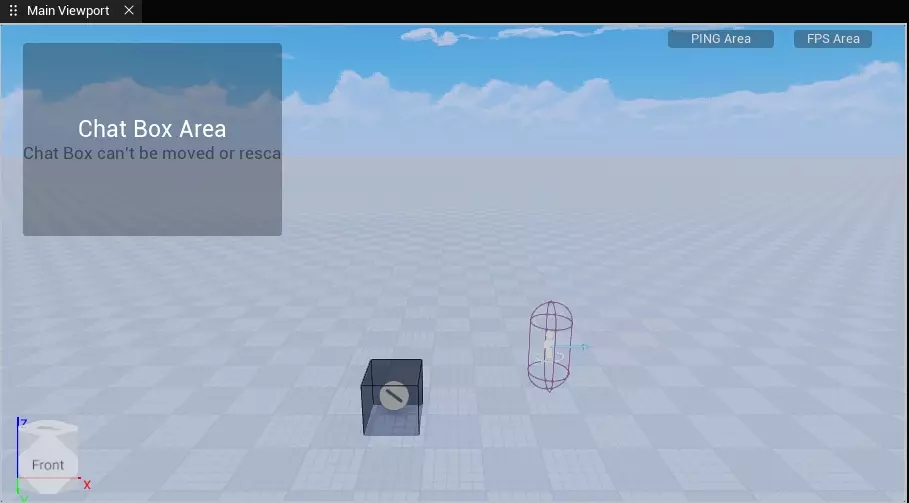 |
- 在右侧【对象管理器】中【对象】栏找到对应的【禁行区】对象并自定义它的属性
| 中文示例 | 英文示例 |
|---|---|
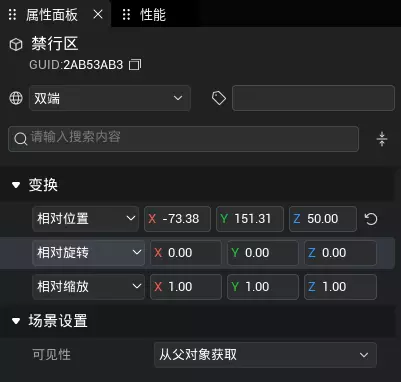 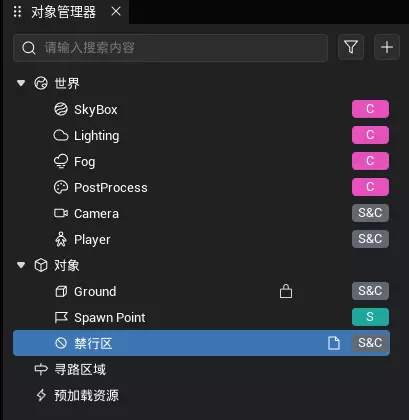 | 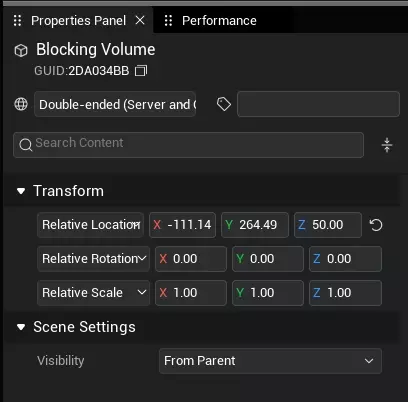 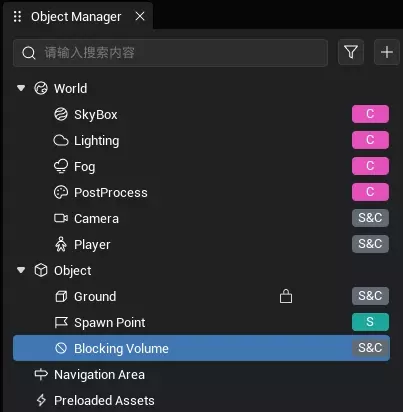 |
通过脚本创建:
通过脚本你也可以在游戏运行时通过【本地资源库】中的【禁行区】资源ID:"Projectile" 动态生成一个【禁行区】对象来使用。在【工程内容】下的脚本目录中新建一个脚本文件,将脚本拖入【对象管理器】中【对象】栏。选中脚本进行编辑,将下列示例代码替换脚本中的onStart方法:异步生成一个【禁行区】对象,开启双端同步,位置为(300,0,50),旋转为(0,0,0),缩放倍数为(1,1,1)。打印生成【禁行区】对象的gameObjectId。
TypeScript
protected async onStart(): Promise<void> {
if(SystemUtil.isServer()) {
let wall = await GameObject.asyncSpawn("BlockingVolume", {replicates: true, transform: new Transform(new Vector(300, 0, 50), Rotation.zero, Vector.one)}) as BlockingVolume;
console.log("wall gameObjectId: " + wall.gameObjectId);
}
}protected async onStart(): Promise<void> {
if(SystemUtil.isServer()) {
let wall = await GameObject.asyncSpawn("BlockingVolume", {replicates: true, transform: new Transform(new Vector(300, 0, 50), Rotation.zero, Vector.one)}) as BlockingVolume;
console.log("wall gameObjectId: " + wall.gameObjectId);
}
}TIP
【禁行区】是一个空间的概念,不仅可以阻止外部的角色进入,同时也可以阻止内部的角色出去。
自定义禁行区
【禁行区】的transform属性将决定它的位置,朝向,大小。而自身函数能给角色动态设置通行权限。在【对象管理器】中【对象】栏找到对应的【禁行区】对象,选中后我们可以查看它的属性面板,通过属性面板我们可以修改它的部分属性。需要注意的是发射【禁行区】需要调用它提供的函数,编辑器修改属性主要是提前配置好它的轨迹参数,方便在脚本中直接使用。
| 中文示例 | 英文示例 |
|---|---|
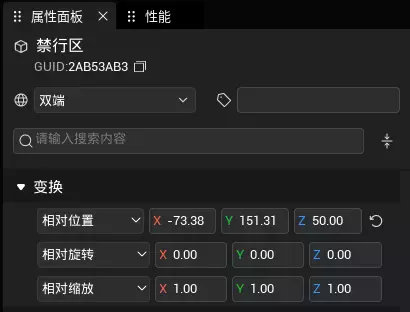 | 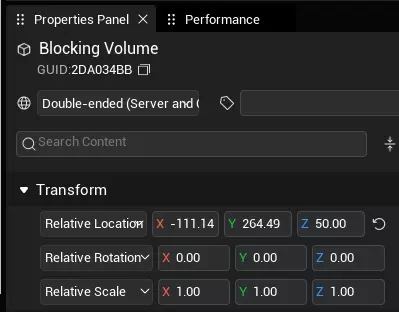 |
TIP
【禁行区】的自定义属性主要就是transform,其他属性对它的功能来说没有太多意义。
禁行区位置
【禁行区】的位置由继承自父类GameObject的worldTransform.position世界位置属性控制,可读可写。你可以在属性面板中修改场景中【禁行区】对象的位置,也可以在代码中动态读写【禁行区】对象的属性来控制它的位置。
| 中文示例 | 英文示例 |
|---|---|
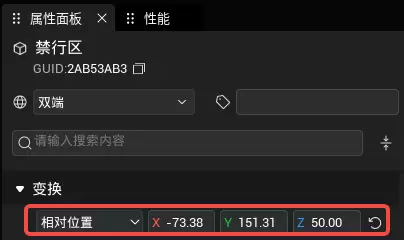 |  |
TypeScript
if(SystemUtil.isServer()) {
let wall = await GameObject.asyncSpawn("BlockingVolume", {replicates: true, transform: new Transform(new Vector(300, 0, 50), Rotation.zero, Vector.one)}) as BlockingVolume;
wall.worldTransform.position = new Vector(300, 0, 50);
console.log("wall worldTransform.position: " + wall.worldTransform.position);
}if(SystemUtil.isServer()) {
let wall = await GameObject.asyncSpawn("BlockingVolume", {replicates: true, transform: new Transform(new Vector(300, 0, 50), Rotation.zero, Vector.one)}) as BlockingVolume;
wall.worldTransform.position = new Vector(300, 0, 50);
console.log("wall worldTransform.position: " + wall.worldTransform.position);
}禁行区旋转
【禁行区】的旋转由继承自父类GameObject的worldTransform.rotation世界旋转属性控制,可读可写。你可以在属性面板中修改场景中【禁行区】对象的旋转,也可以在代码中动态读写【禁行区】对象的属性来控制它的位置。
| 中文示例 | 英文示例 |
|---|---|
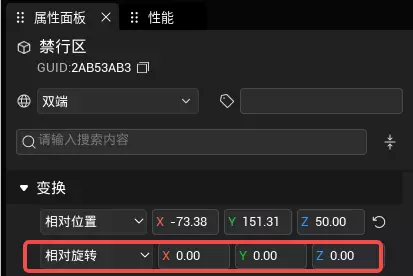 | 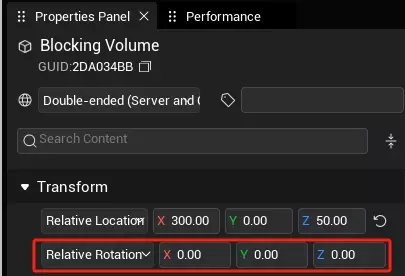 |
TypeScript
if(SystemUtil.isServer()) {
let wall = await GameObject.asyncSpawn("BlockingVolume", {replicates: true, transform: new Transform(new Vector(300, 0, 50), Rotation.zero, Vector.one)}) as BlockingVolume;
wall.worldTransform.rotation = new Rotation(45, 0, 0);
console.log("wall worldTransform.rotation: " + wall.worldTransform.rotation);
}if(SystemUtil.isServer()) {
let wall = await GameObject.asyncSpawn("BlockingVolume", {replicates: true, transform: new Transform(new Vector(300, 0, 50), Rotation.zero, Vector.one)}) as BlockingVolume;
wall.worldTransform.rotation = new Rotation(45, 0, 0);
console.log("wall worldTransform.rotation: " + wall.worldTransform.rotation);
}禁行区大小
【禁行区】的大小可以由继承自父类GameObject的worldTransform.scale世界缩放属性控制,可读可写。当【禁行区】形状为盒体时,XYZ值分别表示盒体的长宽高。
| 中文示例 | 英文示例 |
|---|---|
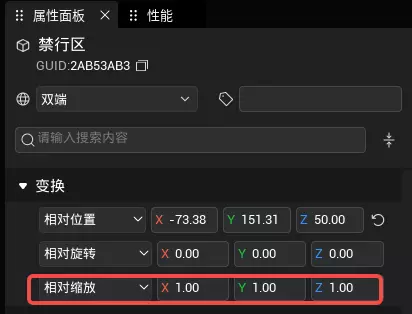 | 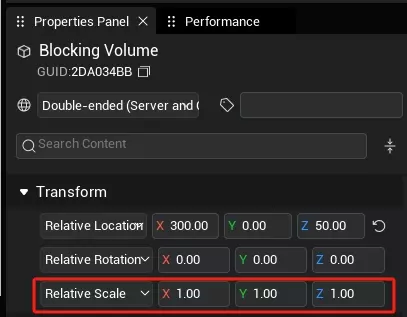 |
TypeScript
// 通过scale属性设置禁行区大小
if(SystemUtil.isServer()) {
let wall = await GameObject.asyncSpawn("BlockingVolume", {replicates: true, transform: new Transform(new Vector(300, 0, 50), Rotation.zero, Vector.one)}) as BlockingVolume;
wall.worldTransform.scale = new Vector(2, 2, 2);
wall.worldTransform.scale = new Vector(300, 0, 50);
console.log("wall worldTransform.scale: " + wall.worldTransform.scale);
}// 通过scale属性设置禁行区大小
if(SystemUtil.isServer()) {
let wall = await GameObject.asyncSpawn("BlockingVolume", {replicates: true, transform: new Transform(new Vector(300, 0, 50), Rotation.zero, Vector.one)}) as BlockingVolume;
wall.worldTransform.scale = new Vector(2, 2, 2);
wall.worldTransform.scale = new Vector(300, 0, 50);
console.log("wall worldTransform.scale: " + wall.worldTransform.scale);
}使用禁行区
获取禁行区对象
【对象管理器】中【对象】栏下的【禁行区】对象:
使用asyncFindGameObjectById接口通过【禁行区】对象的gameObjectId去获取:
- 选中【禁行区】对象后右键点击【复制对象ID】获取它的gameObjectId。此处注意区分【禁行区】资源的ID和【禁行区】对象的gameObjectId。
| 中文示例 | 英文示例 |
|---|---|
 | 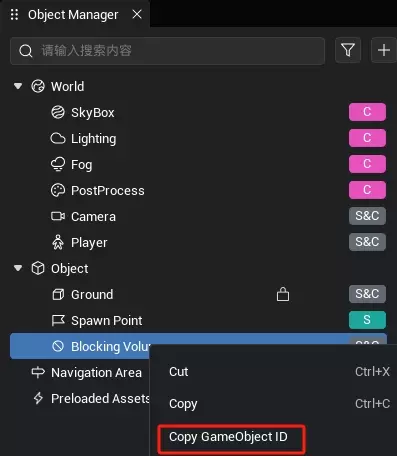 |
- 将脚本拖入对象管理器下,用下列代码替换脚本中的
onStart方法:代码将异步查找ID对应的对象以【禁行区】对象进行接收。
TypeScript
protected async onStart(): Promise<void> {
if(SystemUtil.isServer()) {
let wall = await GameObject.asyncFindGameObjectById("13CB1A8B") as BlockingVolume;
console.log("wall gameObjectId " + wall.gameObjectId);
}
}protected async onStart(): Promise<void> {
if(SystemUtil.isServer()) {
let wall = await GameObject.asyncFindGameObjectById("13CB1A8B") as BlockingVolume;
console.log("wall gameObjectId " + wall.gameObjectId);
}
}使用脚本挂载的方式进行获取:
- 选中【禁行区】对象,将脚本挂载到【禁行区】对象下方
| 中文示例 | 英文示例 |
|---|---|
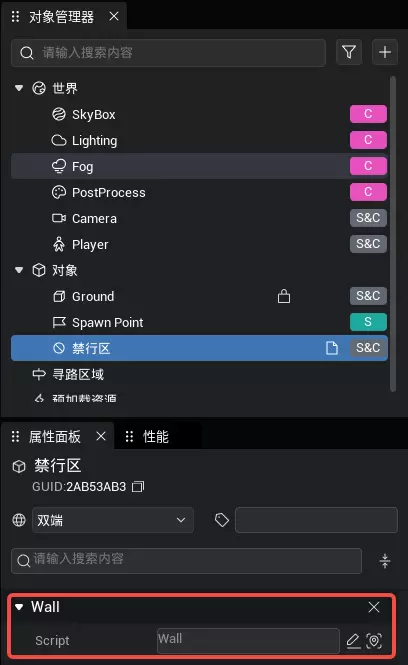 | 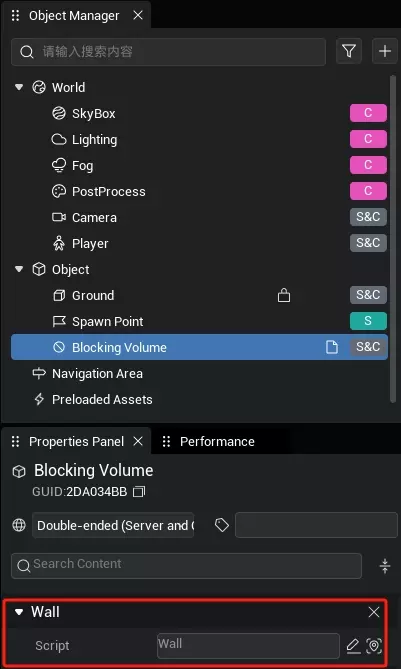 |
- 在脚本的onStart方法中添加下列代码:代码获取脚本挂载的对象并以【禁行区】对象进行接收
TypeScript
let wall = this.gameObject as BlockingVolume;let wall = this.gameObject as BlockingVolume;动态生成的【禁行区】对象:
将下列示例代码替换脚本中的onStart方法:示例代码在客户端往asyncSpawn接口(中传入【禁行区】的资源ID“BlockingVolume”异步生成了一个对应的【禁行区】对象。
TypeScript
protected async onStart(): Promise<void> {
if(SystemUtil.isServer()) {
let wall = await GameObject.asyncSpawn("BlockingVolume", {replicates: true, transform: new Transform(new Vector(300, 0, 50), Rotation.zero, Vector.one)}) as BlockingVolume;
console.log("wall gameObjectId: " + wall.gameObjectId);
}
}protected async onStart(): Promise<void> {
if(SystemUtil.isServer()) {
let wall = await GameObject.asyncSpawn("BlockingVolume", {replicates: true, transform: new Transform(new Vector(300, 0, 50), Rotation.zero, Vector.one)}) as BlockingVolume;
console.log("wall gameObjectId: " + wall.gameObjectId);
}
}设置单个对象的通行权限
【禁行区】通过addPassableTarget和removePassableTarget两个接口来设置具体对象的通行权限。当对象获得通过【禁行区】的权限后可以自由通行,未获得权限的对象会受到阻挡(如果对象本身需具备碰撞能力)。将下列示例代码复制到脚本中的onStart方法中:首先获取脚本挂载的【禁行区】对象。在客户端获取本地玩家角色后添加两个按键方法:按下“1”键给本地角色添加该【禁行区】的通过权限;按下“2”键给本地角色移除该【禁行区】的通过权限;
TypeScript
let wall = this.gameObject as BlockingVolume;
if(SystemUtil.isClient()) {
let myself = Player.localPlayer.character;
InputUtil.onKeyDown(Keys.One, () => {
wall.addPassableTarget(myself);
});
InputUtil.onKeyDown(Keys.Two, () => {
wall.removePassableTarget(myself);
});
}let wall = this.gameObject as BlockingVolume;
if(SystemUtil.isClient()) {
let myself = Player.localPlayer.character;
InputUtil.onKeyDown(Keys.One, () => {
wall.addPassableTarget(myself);
});
InputUtil.onKeyDown(Keys.Two, () => {
wall.removePassableTarget(myself);
});
}获取对象是否有通行权限
【禁行区】提供getTargetPassable接口去获取当前对象是否有通行权限。将下列示例代码补充到上例中:每次设置完本地角色的通过权限后打印结果。
TypeScript
let wall = this.gameObject as BlockingVolume;
if(SystemUtil.isClient()) {
let myself = Player.localPlayer.character;
InputUtil.onKeyDown(Keys.One, () => {
wall.addPassableTarget(myself);
console.log("passable: " + wall.getTargetPassable(myself));
});
InputUtil.onKeyDown(Keys.Two, () => {
wall.removePassableTarget(myself);
console.log("passable: " + wall.getTargetPassable(myself));
});
}let wall = this.gameObject as BlockingVolume;
if(SystemUtil.isClient()) {
let myself = Player.localPlayer.character;
InputUtil.onKeyDown(Keys.One, () => {
wall.addPassableTarget(myself);
console.log("passable: " + wall.getTargetPassable(myself));
});
InputUtil.onKeyDown(Keys.Two, () => {
wall.removePassableTarget(myself);
console.log("passable: " + wall.getTargetPassable(myself));
});
}对整个禁行区设置通行权限
【禁行区】通过clear和unblockAll两个接口来设置具体场景内所有对象的通行权限。调用clear接口后,所有对象的通过权限都将被移除;调用unblockAll接口后,所有对象都将添加该【禁行区】的通过权限;将下列示例代码补充到上例中:添加两个按键方法:按下“3”键给所有角色移除该【禁行区】的通过权限;按下“4”键给所有角色添加该【禁行区】的通过权限;
TypeScript
let wall = this.gameObject as BlockingVolume;
if(SystemUtil.isClient()) {
let myself = Player.localPlayer.character;
InputUtil.onKeyDown(Keys.One, () => {
wall.addPassableTarget(myself);
console.log("passable: " + wall.getTargetPassable(myself));
});
InputUtil.onKeyDown(Keys.Two, () => {
wall.removePassableTarget(myself);
console.log("passable: " + wall.getTargetPassable(myself));
});
InputUtil.onKeyDown(Keys.Three, () => {
wall.clear();
console.log("passable: " + wall.getTargetPassable(myself));
});
InputUtil.onKeyDown(Keys.Four, () => {
wall.unblockAll();
console.log("passable: " + wall.getTargetPassable(myself));
});
}let wall = this.gameObject as BlockingVolume;
if(SystemUtil.isClient()) {
let myself = Player.localPlayer.character;
InputUtil.onKeyDown(Keys.One, () => {
wall.addPassableTarget(myself);
console.log("passable: " + wall.getTargetPassable(myself));
});
InputUtil.onKeyDown(Keys.Two, () => {
wall.removePassableTarget(myself);
console.log("passable: " + wall.getTargetPassable(myself));
});
InputUtil.onKeyDown(Keys.Three, () => {
wall.clear();
console.log("passable: " + wall.getTargetPassable(myself));
});
InputUtil.onKeyDown(Keys.Four, () => {
wall.unblockAll();
console.log("passable: " + wall.getTargetPassable(myself));
});
}TIP
【禁行区】请尽量放置在场景中,不推荐动态生成。此外【禁行区】不支持重叠使用。